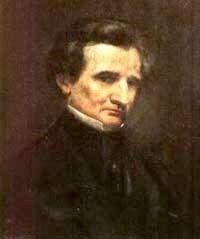Anyone who has seen Chris Matthews' Hardball on MSNBC recently, is aware of a feature he calls The Big Number.
Well, I have my own BIG NUMBER for today.
And that number is 164 !!!
Why 164?

Portrait of Hector Berlioz
164 is the age of the first ever piece written for saxophone.
And I do mean the first ever.
February 3rd, 1844 was the premiere of Hector Berlioz's Chant sacré, which was a showcase piece written to demonstrate Adolphe Saxe's collection of innovative instrument at a trade fair in Paris.
The piece was orchestrated for clarinet, bass-clarinet, bass saxophone, cornet, bugle & high trumpet.
Although the clarinets and brass instruments already existed, those presented on this premiere were insturments which Saxe had improved upon the existing models. But, of course, the truly new element which was introduced was the bass saxophone (it is unclear whether we are talking about a true bass saxophone or what we now call a baritone saxophone).Berlioz, one of history's greatest orchestrators had a high esteem for Saxe and his creations. He mentions the saxophone in his Orchestration Treatise (Grand Traité d'instrumentation et Orchestre modernes) which was first published in 1844. It is unfortunate that the saxophone arrived on the latter part of his life, after most of his important orchestral works had already been written: Symphonie Fantastique (1830), Harold en Italie (1834), Roméo et Juliette (1839). He did include the saxophone in his Grande symphonie funèbre et triomphale, which was for military band.
It is one of the many quirks of history which plagued the saxophone throughout the 19th century and which certainly played against the standardizing the use of the saxophone as a symphonic instrument, one of Adolphe Saxe's dreams. Had Berlioz, the most influential orchestrator of his time, had the saxophone available a decade earlier, I have no doubt he would have welcomed the addition of the sax in his orchestral palette and, with his genius for orchestral coloration, would have certainly highlighted such an amazing timbre that the saxophone represents. Who knows how far the saxophone's life in the orchestra would have gone.
But that is another story. Let's be grateful that Berlioz was so closely involved in introducing the saxophone to the world.
So, let's all raise a glass to today's big number,
and the friendship between Saxe and Berlioz
which gave the saxophone such a wonderful send off.
![]()
